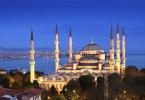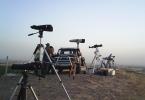Translated by ICOP Member: Omar Bouderdaben
Over the Muslim world, Muslims will be watching for the crescent moon of Ramadhan on Monday, July 8th 2013. On that day, the Moon will set before or with the setting of the Sun in most Muslim countries. This fact will make the sighting of the crescent impossible, and for the countries requiring the eye sighting of the crescent to start the month, it would make Tuesday, July 9th the 30th day and the completion of the month of Shaaban. Hence, the first of the blessed month of Ramadhan will be Wednesday, July 10th 2013.
Over the Muslim world, Muslims will be watching for the crescent moon of Ramadhan on Monday, July 8th 2013. On that day, the Moon will set before or with the setting of the Sun in most Muslim countries. This fact will make the sighting of the crescent impossible, and for the countries requiring the eye sighting of the crescent to start the month, it would make Tuesday, July 9th the 30th day and the completion of the month of Shaaban. Hence, the first of the blessed month of Ramadhan will be Wednesday, July 10th 2013.
For the Muslim communities and countries that do not require the eye sighting of the crescent, and accept the Astronomical calculation, and require only that the that it sets after the setting of the Sun even after couple minutes; and since, on Monday July 8th, the crescent would set few minutes after the setting of the Sun in the Southern countries of the Muslim countries; and since there is a possibility to sight it using a telescope from South America, then, Tuesday, July 9th 2013 is the First day of the Blessed month of Ramadhan.
In summary, the first day of the blessed month of Ramadhan for the Muslim world that requires eye-sighting, would be July 10th, and it would be July 9th for those countries requiring only Astronomical calculation.
On July 8th, because the crescent sets before or at the setting of the Sun, the eye-sighting would be impossible from all northern and some central location. This would include: Iraq, Syria, Saudi Arabia and northern countries of Africa. For the rest of the Muslim countries, the eye-sighting would be also impossible, even with a telescope, because the crescent sets only few minutes after the Sun.
In Nouakchott, Mauritania, the crescent would stay the longest after the Sun set. The eye-sighting in all those locations is either impossible or improbable even with the use of a telescope due to the fact the shortest time recorded during which the crescent was sighted is 29 minutes. Keep in mind that the setting of the bottom side to the crescent is the one used, not the top side; this is so because it is the most important and when the bottom side is not set yet, the whole crescent or most of it is present when the bottom side while the top side would be darker.
The Islamic Crescent Observation Project (ICOP) requests the authorities in the Muslim countries to double check and to confirm any reported sighting on Monday July 8th. During all past historical records of moon sightings, no definitive and no credible report, by eye-sighting nor a telescope, was recorded in similar situations. ICOP also considers a report on that day would be claiming that a human being has eyesight better than the most powerful telescope there is. This would be a clear disregard to scientific facts which our religion holds in great respect.
It is worth mentioning that a multitude of Muslim Scholars of Fiqh and of Astronomy thinks that there is no need to ask people to observe the crescent when Astronomy has determined that it sets before the Sun, as there is no crescent to observe. Therefore it would be clearly and definitely impossible to sight the crescent on that day. One of the directives of the second Emirates Astronomical conference, which was attended by many Muslim scholars of Fiqh and decision makers from the many Muslim countries, states: “If Astronomy determines that the conjunction of the moon and the and the Sun does not happen before Sun set, or the crescent sets before the Sun on the 29th of the Islamic month, there is no need to call people to observe the crescent”. The scholars also agree that this directive is not against the Sunnah of our beloved messenger, peace be upon him, to sight the moon, as this is only in situations where it is known with certainty that there is no crescent to observe. Therefore, observing the crescent with a definite knowledge that is not there is tantamount to ignoring mind and science. Some of the scholars supporting this directive are: Ma’ali Sheikh Abdullah Ibn Mani’, member of organism of the grand scholars of Saudi Arabia and consultant to the Royal office. This directive is also followed by the majority of the Muslim countries that require the eye-sighting of the crescent to start the month.
To find more about the sighting of crescent for the blessed month of Ramadhan, please visit “Islamic Crescent Observation Project, ICOP” at the following link: “ http://www.icoproject.org “. The organization was established in 1998. It has more than 400 members of scholars and professional interested in Astronomy and the observation of the moon and calendar calculation. ICOP encourages anyone interested from the world over to observe the moon and send their observations to ICOP through the web site, which would be published on the web site after verification.
The below map below show the visibility of the crescent on Monday, July 8th 2013:
• Areas colored red: Sighting impossible because either the noon sets before the sun or the conjunction occurs after sun set
• Areas with no color: Sighting not probable even using a telescope
• Areas colored bleu: Sighting possible only with a telescope.
• Areas colored magenta: Sighting possible with a telescope and possible with unaided eye if the weather is clear and the observer is experienced

















